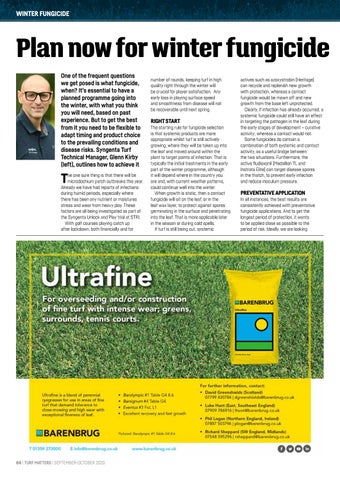stadium WINTER FUNGICIDE of light
Plan now for winter fungicide One of the frequent questions we get posed is what fungicide, when? It’s essential to have a planned programme going into the winter, with what you think you will need, based on past experience. But to get the best from it you need to be flexible to adapt timing and product choice to the prevailing conditions and disease risks. Syngenta Turf Technical Manager, Glenn Kirby (left), outlines how to achieve it
T
he one sure thing is that there will be microdochium patch outbreaks this year. Already we have had reports of infections during humid periods, especially where there has been any nutrient or moistures stress and wear from heavy play. These factors are all being investigated as part of the Syngenta Unlock and Play trial at STRI. With golf courses playing catch up after lockdown, both financially and for
64 | Turf Matters | SEPTEMBER-OCTOBER 2020
number of rounds, keeping turf in high quality right through the winter will be crucial for player satisfaction. Any early loss in playing surface speed and smoothness from disease will not be recoverable until next spring.
Right start The starting rule for fungicide selection is that systemic products are more appropriate whilst turf is still actively growing, where they will be taken up into the leaf and moved around within the plant to target points of infection. That is typically the initial treatments in the early part of the winter programme, although it will depend where in the country you are and, with current weather patterns, could continue well into the winter. When growth is static, then a contact fungicide will sit on the leaf, or in the leaf wax layer, to protect against spores germinating in the surface and penetrating into the leaf. That is more applicable later in the season or during cold spells. If turf is still being cut, systemic
actives such as azoxystrobin (Heritage) can recycle and replenish new growth with protection, whereas a contact fungicide would be mown off and new growth from the base left unprotected. Clearly, if infection has already occurred, a systemic fungicide could still have an effect in targeting the pathogen in the leaf during the early stages of development – curative activity; whereas a contact would not. Some fungicides do contain a combination of both systemic and contact activity, as a useful bridge between the two situations. Furthermore, the active fludioxonil (Medallion TL and Instrata Elite) can target disease spores in the thatch, to prevent early infection and reduce inoculum pressure.
Preventative application In all instances, the best results are consistently achieved with preventative fungicide applications. And to get the longest period of protection, it wants to be applied close as possible to the period of risk. Ideally, we are looking
